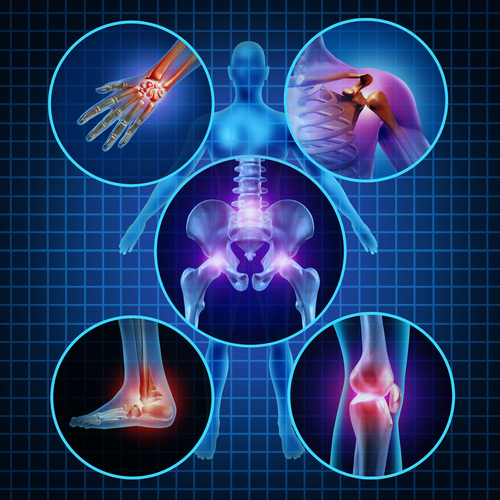When was the last time you said thank you to your joints? How often do you stop and think about the significant role your joints play in the quality of your day to day life? If you’re like most people, not often enough.
It’s not until our joints start acting up that we pay them much attention. But obviously, the more attention you give your joints now, the less likely you are to experience significant pain and inflammation.
How Exactly Do Our Joints Work?
You most likely know that a joint is where two or more bones come together. Joints can be rigid (such as the bones in your skull), or they can be movable like the ones in your shoulders, knees and hips. Many of the joints in your body have cartilage on the ends of the joints where the bones actually meet.
Healthy cartilage allows our bones to glide smoothly over one another and this fluid motion helps us to move easily. The cartilage also protects our bones by preventing them from rubbing together.
When Your Joints Become Painful
Sometimes damage to the joints can interfere with your movement and cause you a lot of pain. There are many different conditions that can lead to painful joints:
Rheumatoid Arthritis
Rheumatoid Arthritis (RA) is a chronic inflammatory disorder that effects millions of Americans. The damage is typically localized in the small joints of the hands and feet. RA affects the lining of the joints and causes a painful swelling that can eventually lead to bone erosion and deformity of the joints.
RA is an autoimmune disorder and occurs when the body’s own immune system mistakenly attacks the body’s tissues. What many don’t know is that besides effecting the joints, RA can also negatively impact other organs in the body such as lungs, blood vessels, eyes and skin.
Rheumatoid arthritis can occur at any age, but is most common in people (especially women) over the age of forty.
Osteoarthritis
Many people confuse osteoarthritis with RA but, although these diseases have symptoms in common, most notably reduced mobility with severe pain, they have distinct causes. Unlike RA, osteoarthritis is not an autoimmune disorder. It can be caused by a couple of different things: common wear and tear over time or by injury to the joints. Both result in degeneration to the hard, smooth layer of the cartilage we spoke of earlier that normally protects the ends of the bones.
Lupus
Unlike RA and osteoarthritis, Lupus typically occurs in young women. The disease affects various organs throughout the body, and symptoms include facial rash, sun-sensitive rashes, hair loss, oral ulcers, and seizures.
Infections
Sometimes the joints can become infected when bacteria or viruses get into the space. When this happens, a local immune response occurs which brings about swelling and pain. Since bacterial infections tend to be localized, the swelling and severe pain will only affect one single joint.
While viruses such as hepatitis B and C and HIV can affect a single joint, they also have the ability to cause a generalized reaction that affects multiple joints around the body.
Gout
When the uric acid crystals that form with gout get into the joint, patients can experience acute pain and swelling.
Fibromyalgia
Although fibromyalgia can also cause joint pain, it differs from rheumatoid arthritis by the associated pain in soft tissue and the absence of swollen joints. Fibromyalgia is yet to be fully understood but it seems that with this condition the body’s perception of normal stimuli is altered so that widespread pain occurs, frequently in the joints.
In all of these conditions joint pain can range from slight to debilitating and can be acute or chronic. But even short-term swelling and joint pain can negatively impact the quality of your life.
Joint pain affects people differently, although it effects men and women equally. Some people experience mild pain while others severe. Some experience it only for a few months or a year and then the pain subsides. Other people have mild symptoms that chronically flare up over years. And still other poor souls have debilitating pain much of the time that lasts their entire life.
Joint pain doesn’t just effect a person’s health but every aspect of life from work to family. And perhaps the saddest fact is that joint pain can strip a person’s ability to enjoy life and take part in the events that bring them the most happiness.
For these reasons it is obvious that many people with joint pain suffer from low self-esteem, anxiety and sometimes severe depression.
How to End Joint Pain Once and For All
Keeping your joints healthy will allow you to take part in your favorite activities. Imagine being able to walk, run, bike, or garden without pain. Luckily, science is now proving that instead of simply masking the symptoms with prescription drugs, more effective treatments get to the root of the problem and tackle it through a combination of physical activity and a balanced diet.
If you are interested in ending your joint pain using natural means that have been shown to be incredibly effective, you’ll definitely want to keep your eye out for our next couple of blog posts where we’ll share some information that could help you to easily manage your joint pain.
Healthy joints can mean the difference between living a full enjoyable life… or dismal one. The next blog post will be all about how you can NATURALLY maintain good health for your joints – you don’t want to miss it!
 Validating...
Validating... 





2 Comments